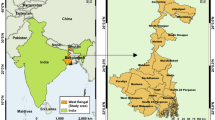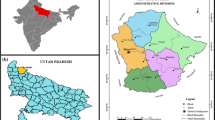Abstract
Land suitability analysis allows identifying limiting factors for agricultural production and enables decision-makers to formulate efficient agricultural management plans. In the present study, GIS-based multi-criteria decision-making (MCDM) land suitability analysis was carried out for sustainable development of agriculture. Ten variables such as drainage, depth, rainfall, pH, slope, soil texture, distances to a major road and the closest town, and flooding risk were investigated to access cropland suitability in Bijnor. These suitability factors were ranked by Fuzzy analytical hierarchy process and the resulting weights were used to generate suitability map layers. The final suitability maps of major crops were using weighted overlay analysis. The findings revealed that sugarcane, wheat, paddy, and oilseed had largest area under moderately suitable class as land in this category had minor limitations. Alkaline soil reaction, gentle slope and shallow soil depth were the main limiting factors in this category. A fairly remarkable area under each crop selected was also found under marginal suitable category. These areas could be made suitable by modifying land-quality parameters. The methodology adopted and its application procedures can be utilized to evaluate land suitability and to suggest best agricultural practices.









Similar content being viewed by others
References
Adeniyi PO (1993) Integration of remote sensing and GIS for agricultural resource management in Nigeria. EARSeL Adv Remote Sens 23:6–211
Ahamed N, Rao GTR, Murthy JSR (2000) GIS-based fuzzy membership model for crop-land suitability analysis. Agric Syst 63:75–95
Ahmed R, Sajjad H, Husain I (2017) Morphometric parameters-based prioritization of sub-watersheds using fuzzy analytical hierarchy process: a case study of lower Barpani watershed, India. Nat Resour Res 27(1):67–75
Akinci H, Ozalp AY, Turgut B (2013) Agriculture land use suitability analysis using GIS and AHP technique. Comput Electron Agric 97:71–82
Bailey JT, Boryan CG (2010) Remote sensing applications in agriculture at the United States Department of Agriculture (USDA), National Agricultural Statistics Service (NASS)
Bandyopadhyay S, Jaiswal RK, Hegde VS, Jayaraman V (2009) Assessment of land suitability potentials for agriculture using a remote sensing and GIS-based approach. Int J Remote Sens 30:879–895
Bhuvan, Indian Geo-platform of Indian Space Research Organization (ISRO). http://bhuvan.nrsc.gov.in/. Assessed 21 Aug 2016
Bodaghabadi MB, Martínez-Casasnovas JA, Khakili P, Masihabadi MH, Gandomkar A (2015) Assessment of the FAO traditional land evaluation methods, a case study: Iranian land classification method. Soil Use Manag 31:384–396
Bozdağ A, Yavuz F, Günay AS (2016) AHP and GIS-based land suitability analysis for Cihanbeyli (Turkey) Country. Environ Earth Sci 75:813
Burroug PA (1989) Fuzzy mathematical methods for soil survey and land evaluation. J Soil Sci 40:477–492
Cengiz T, Akbulak C (2009) Application of analytical hierarchy process and geographic information systems in land-use suitability evaluation: a case study of Dümrek village, Çanakkale, Turkey. Int J Sustain Dev World Ecol 16:286–294
Census of India (2011) District census handbook, Bijnor: village and town directory. Directorate of census operations, Uttar Pradesh, 10(12-a)
Chang DY (1996) Applications of the extent analysis method on fuzzy AHP. Eur J Oper Res 95:649–655
Chen J (2014) GIS-based multi-criteria analysis for land use suitability assessment in City of Regina. Environ Syst Res 3:1–10
Collins MG, Steiner FR, Rushman MJ (2001) Land-use suitability analysis in the United States: historical development and promising technological achievements. Environ Manag 28:611–621
Deng H (1999) Multicriteria analysis with fuzzy pairwise comparisons. Int J Approx Reason 21:215–231
Elaalem M, Comber A, Fisher P (2010) Land evaluation techniques comparing fuzzy AHP with TOPSIS methods. In: 13th AGILE international conference on geographic information science, Guimares, Portugal, pp 1–8
Elsheikh R, Rashid A, Shariff M, Amiri F, Ahmad NB, Balasundram KS, Soom MAM (2013) Agriculture land suitability evaluator (ALSE): a decision and planning support tool for tropical and subtropical crops. Comput Electron Agric 93:98–110
Food and Agricultural Organization of the United Nations FAO (1976) A framework for land evaluation, Soil Bulletin 32. Italy, Rome
Food and Agriculture Organization of the United Nations FAO (1983) Guidelines: land evaluation for rainfed agriculture. In: FAO, soils bulletin 52. Rome, Italy
Food and Agriculture Organization of the United Nations FAO (1985) Guidelines: land evaluation for irrigated agriculture. Soils Bulletin 55, Rome, Italy: FAO. 231 pp. S590. F68 no. 55
Godfray H, Garnett T (2014) Food security and sustainable intensification. Phil Trans R Soc B. https://doi.org/10.1098/rstb.2012.0273
Goswami SB, Matin S, Saxena A, Bairagi GD (2012) A review: the application of remote sensing, GIS, and GPS in precision agriculture. Int J Adv Technol Eng Res (IJATER) 2:50–54
Halder JC (2013) Land suitability assessment for crop cultivation by using remote sensing and GIS. J Geogr Geol 5:65–74
Hopkins L (1977) Methods for generating land suitability maps: an evaluation. J Am Inst Plan 34:19–29
Indian Meteorological Department (2013) Climate profile of India. MET monograph, environment meteorology. Ministry of Earth Sciences, Government of India
Jamil M, Ahmed R, Sajjad H (2017) Land suitability assessment for sugarcane cultivation in Bijnor district, India using geographic information system and fuzzy analytical hierarchy process. Geo J 83(3):595–611
Joss BN, Hall RJ, Sidders DM, Keddy TJ (2008) Fuzzy-logic modeling of land suitability for hybrid poplar across the Prairie Provinces of Canada. Environ Monit Assess 141:79–96
Kalogirou S (2002) Expert systems and GIS: an application of land suitability evaluation. Comput Environ Urban Syst 26:89–112
Kasturirangan K (1995) Remote sensing in India—present scenario and future thrust. J Indian Soc Remote Sens 23:1–6
Kazemi H, Sarvestani ZT, Kamkar B, Shataei S, Sadeghi S (2015) Ecological zoning for wheat production at province scale using geographical information system. Adv Plants Agric Res 2(1):35–42
Land record officer & Economics and statistical department (2014) Block wise land usage in the district, Spider District Sankhyikiya Patrika, Government of Uttar Pradesh
Malczewski J (2002) Fuzzy screening for land suitability analysis. Geograph Environ Model 6:27–39
Malczewski J (2004) GIS-based land suitability: a critical overview. Progr Plan 62:3–65
Malczewski J (2006) Ordered weighted averaging with fuzzy quantifiers: GIS-based multicriteria evaluation for land-use suitability analysis. Int J Appl Earth Obs Geoinf 8:270–277
Malczewski J (1999) GIS and multicriteria decision analysis. Wiley, New York
McClung CR (2014) Making hunger yield. Science 344:699–700
Mikhailov L, Tsvetinov P (2004) Evaluation of services using a fuzzy analytic hierarchy process. Appl Soft Comput 5:23–33
Ministry of Agriculture and Farmers Welfare. (2015) Soil testing lab data, Bijnor. Department of Agriculture and Cooperation and Farmers Welfare, Government of India
Nazeri Z, Mirzaee J, Rostami A (2014) Application of analytical hierarchy process in land suitability for forest park location (case study: Ilam county, Iran. J Biodivers Environ Sci 4:301–309
Orhan D, Bayramin I, Mahmut Y (2003) Geographic information systems and remote sensing based land evaluation of Beypazari area soils by ILSEN model. Turk J Agric For 27:145–153
Pan G, Pan J (2012) Research in cropland suitability analysis based on GIS. IFIP Int Fed Inf Process 66:314–325
Qiu F, Chastain B, Zhou Y, Zhang V, Sridharan H (2014) Modeling land suitability/capability using fuzzy evaluation. GeoJournal 79:167–182
Qiu J, Tang M, Frolking S, Boles S, Li C, Xiao X, Liu J, Zhuang Y, Qin X (2003) Mapping single, double, and triple crop agriculture in China at 0.5° × 0.5° by combining country scale census data with a remote sensing-derived Land cover map. Geocarto Int 18:3–13
Rasheed S, Venugopal K (2009) Land suitability assessment for selected crops in Vellore district based on agro-ecological characterisation. J Indian Soc Remote Sens 37:615–629
Rosa DD, Diepen CAV (2002) Qualitative, and quantitative land evaluation, in 1.5. Land Use and Land Cover, in Encyclopedia of Life Support System (EOLSS-UNESCO). Eolss Publishers, Oxford
Saaty TL (1980) The analytic hierarchy process. McGraw-Hill, New York
Sajjad H, Chauhan C, Jamil M (2016) Indebtedness and its causal factors among farmers in Sangroor district, Punjab: a Household level analysis. Trans Inst Indian Geogr 38:101–115
Sajjad H, Nasreen I (2016) Assessing farm-level agricultural sustainability using site-specific indicators and sustainable livelihood security index: evidence from Vaishali district, India. Community Dev 47:602–619
Shearer KS, Xiang WN (2009) Representing multiple voices in landscape planning: a land suitability assessment study for a park land-banking program in Concord, North Carolina, USA. Landsc Urban Plan 93:111–122
Sheng T (1990) Watershed management field manual. FAO conservation guide, Rome, 13/6
Singh SP, Ram J, Walia CS, Sachdev CB, Dhankar RP, Rana KP, Sehgal J, Velayutham M, Gajbhiye KS. Soils of Uttar Pradesh for optimising land use [NBSS Pub]. 68 (Soils of India Series). National Bureau of Soil Survey and Land Use Planning, Nagpur, India
Sys C, Van Ranst E, Debaveye J (1991) Land evaluation part I and II—crop requirement. Belgium General Administration for Development Cooperation. Agricultural Publications No. 7
The Economic Survey 2016–17, Agricultural and Processed Food Products Export Development Authority (APEDA), Department of Commerce and Industry, Union Budget 2017–18, Press Information Bureau, Ministry of Statistics and Programme Implementation, Press Releases, Media Reports
Van Orshoven J, Terres J, Toth T (2012) Updated common bio-physical criteria to define natural constraints for agriculture in Europe. Ispra
Wale A, Collick AS, Rossiter DG, Langan S, Steenhuis TS (2013) Realistic assessment of irrigation potential in the Lake Tana basin, Ethiopia. In: Proceedings of the Nile basin development challenge science meeting, Addis Ababa. NBDC Technical Report 5. Nairobi, Kenya: ILRI
Yalew SG, Van Griensven A, Mul ML, Zaag PVD (2016) Land suitability analysis for agriculture in the Abbay basin using remote sensing, GIS, and AHP techniques. Model Earth Syst Environ 2:101
Zhang J, Su Y, Wu J, Liang H (2015) GIS-based land suitability assessment for tobacco production using AHP and fuzzy set in Shandong province of China. Comput Electron Agric 114:202–211
Acknowledgements
The authors are highly thankful to the anonymous reviewers and the Editor for their constructive comments and suggestions which helped us to improve the overall quality of the manuscript.
Author information
Authors and Affiliations
Corresponding author
Rights and permissions
About this article
Cite this article
Jamil, M., Sahana, M. & Sajjad, H. Crop Suitability Analysis in the Bijnor District, UP, Using Geospatial Tools and Fuzzy Analytical Hierarchy Process. Agric Res 7, 506–522 (2018). https://doi.org/10.1007/s40003-018-0335-5
Received:
Accepted:
Published:
Issue Date:
DOI: https://doi.org/10.1007/s40003-018-0335-5




